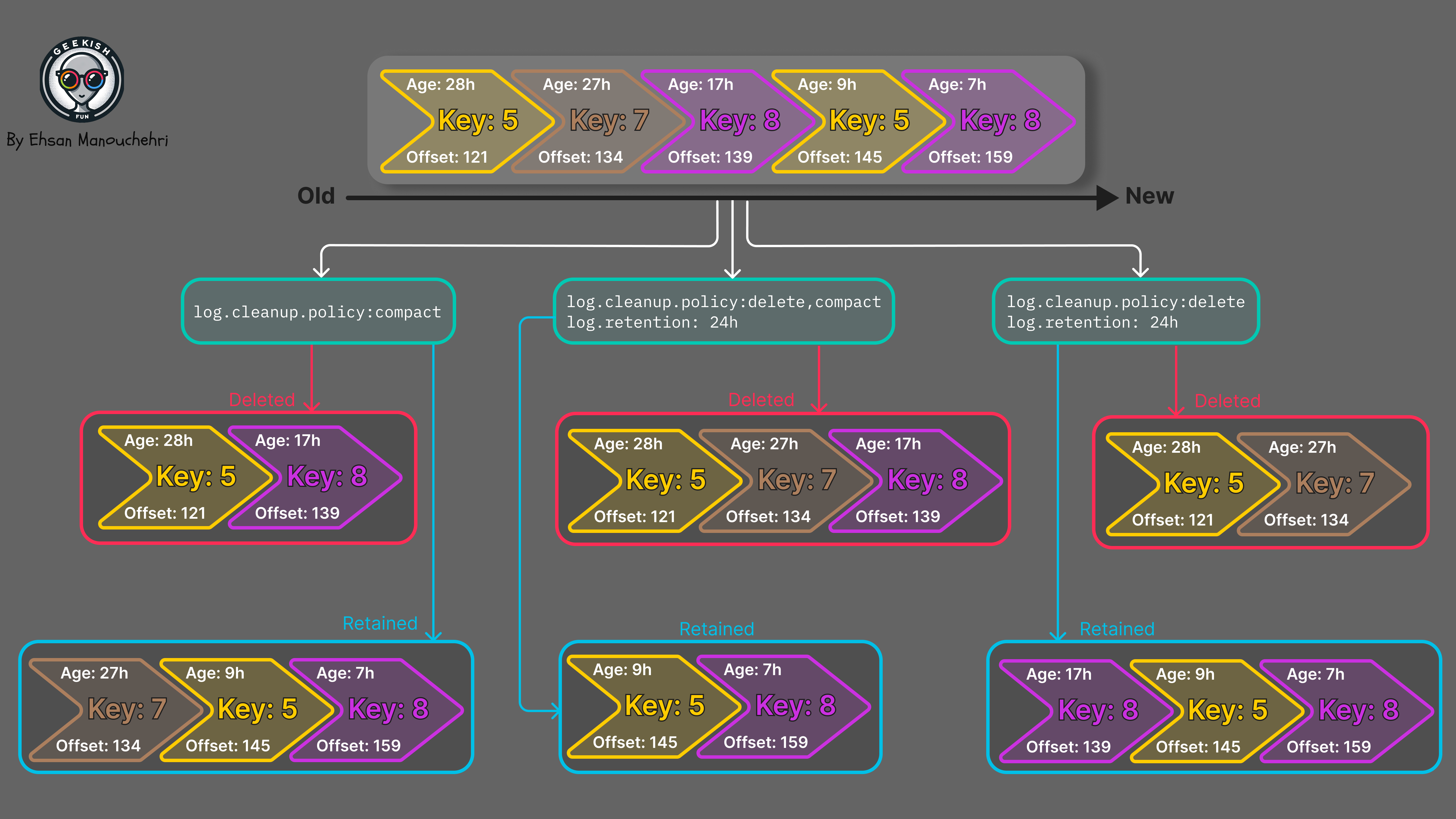Kafka Log Cleanup: Delete vs Compact

When to use cleanup.policy=delete vs compact, with trade-offs, configs, and recipes
Published on October 20, 2025 by Ehsan Manouchehri
Kafka LogCompaction CleanupPolicy Retention EventSourcing
4 min READ
Introduction
Kafka stores records on disk in append-only logs. Cleaning up those logs is critical to control storage cost and to shape the semantics that downstream consumers observe. The cleanup.policy determines how Kafka discards data over time:
delete: remove old segments based on time/size retentioncompact: keep only the latest record per key, using tombstones for deletes
Choosing correctly affects cost, latency, correctness, and how you model data.
TL;DR
- delete: best for ephemeral, immutable events; controlled by retention time/size
- compact: best for latest state per key; requires keys and tombstones
- compact+delete: state with bounded history; keep delete.retention.ms >= max consumer lag
Visual overview

cleanup.policy=delete
Delete retention removes entire segments when they exceed time or size limits.
How it works
- Segments roll by time or size:
segment.ms,segment.bytes - Retention is enforced per topic:
retention.ms,retention.bytes - When segments are older/larger than the configured limits, they are deleted
Pros
- Predictable storage envelope (bytes/time)
- Simple mental model; works for immutable event streams
- Efficient for high-throughput append-only topics
Cons
- No automatic dedup/upsert across keys
- Deletes historical data regardless of key semantics
- Consumers replaying may see very old data vanish mid-replay
Typical use cases
- Ephemeral events, telemetry, metrics, logs
- Request/response, audit trails with bounded retention
- Streams where every event is valuable only for a window
cleanup.policy=compact
Compaction maintains the latest value per key by scanning log segments and discarding older records for the same key. Deletions are represented by tombstones.
How it works
- Records must have keys; compaction is key-based
- The cleaner rewrites segments, keeping the newest record per key
- Deletions are tombstones (records with null value) that cause later removal after
delete.retention.ms - Cleaner behavior settings:
min.cleanable.dirty.ratio: fraction of dirty data that triggers cleaningmax.compaction.lag.ms: latest time to wait before compacting recordsmin.compaction.lag.ms: minimum age before records become eligible for compaction- Broker-level
log.cleaner.threads: number of background cleaner threads
Pros
- Upsert semantics: consumers can hydrate latest state by reading the log
- Efficient for CDC, materialized views, KTable state
- Shrinks disk by removing superseded updates
Cons
- Requires keyed messages; missing keys break expectations
- Cleaner adds background IO/CPU; compaction is eventual, not instantaneous
- Tombstones must be retained long enough for readers to see deletes (
delete.retention.ms)
Typical use cases
- Change Data Capture (CDC) topics (upserts and deletes)
- Entity state streams (user, product, account) used to hydrate caches/stores
- De-duplication feeds; KStreams/KTable state backing topics
Combining compact+delete
Setting cleanup.policy=compact,delete keeps the latest value per key but also enforces a history window. This is useful when you want upsert semantics plus bounded historical replay.
Key interactions:
retention.mslimits how long old segments remain even after compaction- Tombstones are kept for at least
delete.retention.msso that readers can learn deletes - Ensure
delete.retention.ms>= max consumer lag so tombstones propagate to all consumers min/max.compaction.lag.mscan delay or accelerate compaction relative to write time
Operational notes
- Ensure producers set keys consistently; no key -> no compaction benefits
- Size segments sensibly: tiny segments cause overhead; huge segments delay deletes
- Tune cleaner:
log.cleaner.threads, IO throughput; monitor cleaner backlog - Observe metrics: cleaner dirty ratio, bytes cleaned, disk usage per topic-partition
- Plan for consumer behavior: stateful consumers may rely on compaction to converge
Decision guide
| Requirement | Prefer | Notes |
|---|---|---|
| Immutable events, time-bounded history | delete | Simple retention by time/size |
| Latest value per key (upsert) | compact | Consumers hydrate current state |
| Upsert with limited history | compact+delete | Current state plus 30–90 day window |
| Strict storage ceiling | delete | Predictable bytes; compaction is approximate |
| CDC/materialized view | compact | Preserve tombstones long enough |
Conclusion
Start with the semantics you need:
- Choose
deletefor ephemeral, immutable streams with a clear retention window - Choose
compactfor upsert/state streams where latest value per key matters - Combine both to keep current state while bounding history